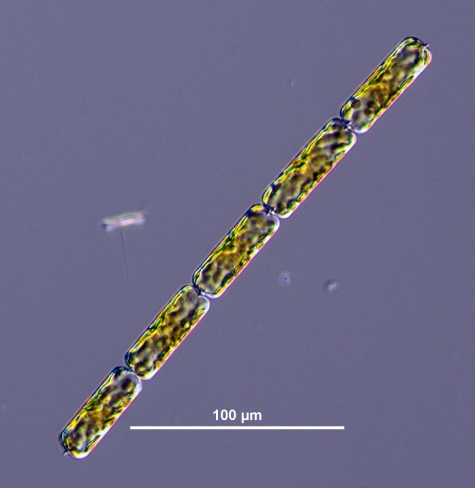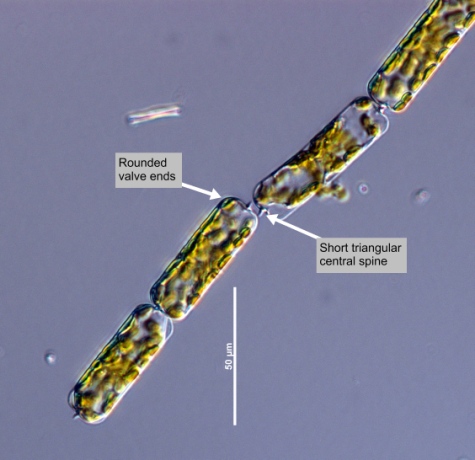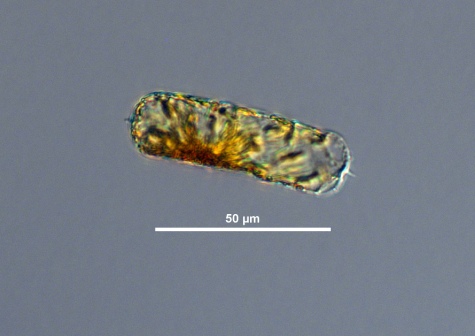



|
Synonym(s)
Basionym
The original name for an organism. In botany, the original published nomenclature from which a new binomial nomenclature is derived for a particular group of organisms (Tindall 1999).
(basionym, CloseHomotypic
Expressing the same fundamental type or structure; may or may not be symmetrical (e.g., the two valves of a diatom, where they are the same shape and appearance, but one is bigger than the other). In naming species, a homotypic synonym is one that comes into being when a taxon gets a new name (without being added to an already existing taxon).
homotypic)(Guiry and Guiry 2011)
Classification
(Guiry and Guiry 2011)
Lifestyle
Description
Valve
In diatoms, the structurally distinct halves of the cell wall (Becker 1996).
Valve ends are rounded and are connected by a short central CloseSpine
In some diatoms, "closed or solid structures projecting from the cell wall;" in dinoflagellates, solid projections that usually taper to a point.
spine that fits into a depression on the adjacent cell. Chloroplasts are numerous and shaped like small plates. Both the chloroplasts and the CloseNucleus
(plural: nuclei) In eukaryotic cells, a membrane-bound organelle that contains the cell's genetic information; the nucleus controls the activities of the cell by controlling gene expression.
nucleus are near the cell wall (Cupp 1943). Cells are yellow-brown in colour (Guiry 2011).Siliceous
Describing the character (i.e., white, shimmery) or chemical presence silicon dioxide (SiO2) as a component of phytoplankton cell covering.
silicified. CloseIntercalary bands
Girdle bands that are furthest away from the valve (Smithsonian 2011).
Intercalary bands are ring or collar-shaped, ending in a straight line (difficult to see with CloseLM
(light microscopy) "Using a microscope in which a beam of light passes through optical lenses to view an image of the specimen" (MCM LTER 2010).
LM; Cupp 1943, Horner 2002). Rectangular ClosePoroid
A simple hole through the surface of a diatom valve (Smithsonian 2011).
poroid CloseAreola(e)
In diatoms, the regularly repeated hexagonal holes on the valve walls (HPP 2003).
areolae are visible under EM (Hasle and Syvertsen 1997).Measurements
Pervalvar axis
The axis through the centre point of the two valves of a frustule. This axis is perpendicular to the valve face.
(pervalvar axis): 40 - 300 μmDiameter: 8 - 70 μm
(Kraberg et al. 2010)
Similar species
Oblique
At a slanted angle (i.e., not parallel or perpendicular).
oblique (instead of central) spines (Cupp 1943).Harmful effects
Sedimentation
(settling out) The tendency for particles to settle out of the water column and come to rest at the bottom due to gravitational forces. Factors that influence the rate of sedimentation are particle size, water density and currents.
sedimentation, blooms can inhibit growth of benthic shellfish by clogging their gills (Lorrain et al. 2000).Habitat
Distribution
Cosmopolitan (Kraberg et al. 2010).
Can be found sporadically in coastal waters throughout the year in Northern European seas (Kraberg et al. 2010). Sometimes forms blooms in autumn to early winter around the Baltic Sea (Łotocka 2006) and in early spring and autumn around Florida (Philips et al. 2010).
"North temperate to Close
Boreal
Relating to the area immediately south of the Arctic.
boreal species. Moderately common off California, but never in large numbers" (Cupp 1943).Growth conditions
Eutrophic/eutrophication
Water that is enriched in natural or artificial mineral and organic matter, which promotes an abundance of plant life (i.e., algae), and can result in reduced oxygen conditions.
eutrophication conditions (Abdalla et al. 1995). May be able to store CloseNutrients
Various chemical substances that an organism needs for metabolism (i.e., to live and grow). These are usually taken up from the environment. Some examples include nitrate, phosphate, silica (for diatoms), iron, copper, etc. Some nutrients, like copper, are required for growth, but can also be toxic at high levels.
nutrients and therefore be adapted to living in environments where nutrient availability is variable (Pinckney et al. 1999, Tozzi et al. 2004, Katz et al. 2005, all cited in Philips et al. 2010).Euphotic
The zone near the surface of the water where the light intensity is sufficient to support net photosynthesis (Letelier et al. 2004). Defined as the area above "the depth at which the photon flux equals 1% of the flux measured just above the air-sea interface" (Ryther 1956).
euphotic zone (Lauria et al. 1999). Increases in abundance have been observed following CloseFreshet
A great rise or overflow of a river from heavy rains or spring thaw. In the Strait of Georgia, this usually occurs from March to June. (pers. comm. D. Cassis).
freshets in the fall (Malej 1995). Often appears together with Guinardia delicatula, Leptocylindrus danicus and Cerataulina pelagica (Hasle and Syvertsen 1997).Environmental Ranges
Temperature range (°C): -1.845 - 29.468
Nitrate (μmol L-1): 0.053 - 28.280
Salinity (PSU): 29.401 - 38.049
Oxygen (mL L-1): 4.444 - 8.768
Phosphate (μmol L-1): 0.046 - 2.337
Close
Silicic acid
A general term to describe chemical compounds containing silicon, oxygen and hydrogen with a general formula of [SiOx(OH)4-2x]n. Diatoms polymerize silicic acid into biogenic silica to form their frustules (Azam and Chisholm 1976).
Silicate (μmol L-1): 0.733 - 59.039(OBIS 2011, cited in EOL 2011)
Bloom characteristics
References
Abdalla, R. R., Zaghloul, F. A. and Hussein, N. R. 1995. A statistical modelling of phytoplankton eutrophication in the Eastern Harbour, Alexandria, Egypt. Bulletin of the National Institute of Oceanography and Fisheries (Egypt). 21(1): 125-146.
Carlsson, P. and Graneli, E. 1999. Effects of N:P:Si ratios and zooplankton grazing on phytoplankton communities in the northern Adriatic Sea. II. Phytoplankton species composition. Aquatic Microbial Ecology. 18(1): 55-65.
Cupp, E. E. 1943. Marine Plankton Diatoms of the West Coast of North America. University of California Press. Berkeley, California. 238.
Encyclopedia of Life (EOL). Dactyliosolen fragilissimus (Bergon) G. R. Hasle. http://www.eol.org/pages/908368. Accessed 02 Aug 2011.
Guiry, M. D. 2011. Dactyliosolen fragilissimus (Bergon) Hasle apud G. R. Hasle and Syvertsen, 1996. http://www.marinespecies.org/aphia.php?p=taxdetails&id=149310. Accessed 02 Aug 2011.
Guiry, M. D. and Guiry, G. M. 2011. Dactyliosolen fragilissimus (Bergon) Hasle. http://www.algaebase.org/search/species/detail/?species_id=42283. Accessed 02 Aug 2011.
Hasle, G. R. and Syvertsen, E. E. 1997. Marine diatoms. In: Tomas, C. R. (ed.) Identifying marine Phytoplankon. Academic Press, Inc., San Diego. 5-385.
Horner, R. A. 2002. A Taxonomic Guide To Some Common Phytoplankton. Biopress Limited, Dorset Press, Dorchester, UK. 200.
Hori, Y., Miyahara, K., Nagai, S., Tsujino, K., Nakajima, M., Yamamoto, K., Yoshida, Y., Araki, N. and Sakai, Y. 1998. Relationships between the dominant phytoplankton and DIN:DIP ratios in Osaka Bay and Harima-Nada. Nippon Suisan Gakkaishi. 64(2): 243-248.
Ishii, K., Ishikawa, A. and Imai, I. 2009. Marine diatoms emerged from in situ surface sediment in a temperate embayment. Phycologia. 48(4, suppl.): 48-48.
Katz, M. E., Finkel, Z. V., Grzebyk, D., Knoll, A. H. and Falkowski, P. G. 2005. Evolutionary trajectories and biogeochemical impacts of marine eukaryotic phytoplankton. Annual Reviews of Ecology and Systematics. 35: 523-556.
Kraberg, A., Baumann, M. and Durselen, C. D. 2010. Coastal Phytoplankton: Photo Guide for Northern European Seas. Verlag Dr. Friedrich Pfeil, Munchen, Germany. 204.
Lauria, M. L., Purdie, D. A. and Sharples, J. 1999. Contrasting phytoplankton distributions controlled by tidal turbulence in an estuary. Journal of Marine Systems. 21: 189-197.
Lorrain, A., Paulet, Y. M., Chauvaud, L., Savoye, N., Nezan, E. and Guerin, L. 2000. Growth anomalies in Pecten maximus from coastal waters (Bay of Brest, France): relationship with diatom blooms. Journal of Marine Biological Association of the United Kingdom. 80(4): 667-673.
Łotocka, M. 2006. The first observed bloom of the diatom Dactyliosolen fragilissimus (Bergon) Hasle 1996 in the Gulf of Gdańsk. Oceanologia. 48(3): 447-452.
Malej, A., Mozetic, P., Malacic, V., Terzic, S. and Ahel, M. 1995. Phytoplankton responses to freshwater inputs in a small semi-enclosed gulf (Gulf of Trieste, Adriatic Sea). Marine Ecology Progress Series. 120 (1-3): 111-121.
Ocean Biogeographic Information System (OBIS). Dactyliosolen fragilissimus. http://www.iobis.org/mapper/?taxon_id=743787. Accessed 02 Aug 2011.
Philips, E. J., Badylak, S., Christman, M. C. and Lasi, M. A. 2010. Climatic trends and temporal patterns of phytoplankton composition, abundance, and succession in the Indian River Lagoon, Florida, USA. Estuaries and Coasts. 33(2): 498-512.
Pinckney, J. L., Paerl, H. W. and Harrington, M. B. 1999. Responses of the phytoplankton community growth rate to nutrient pulses in variable estuarine environments. Journal of Phycology. 35: 1455-1463.
Tozzi, S., Schofield, O. and Falkowski, P. 2004. Historical climate change and ocean turbulence as selective agents for key phytoplankton functional groups. Marine Ecology Progress Series. 274: 123-132.
